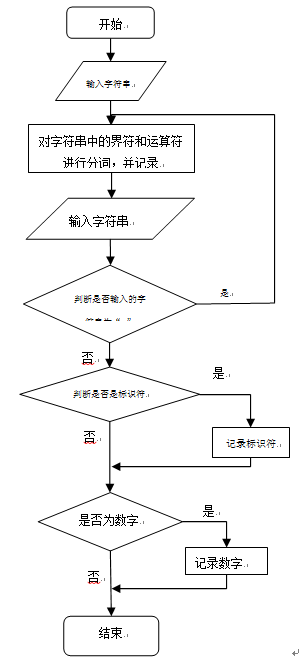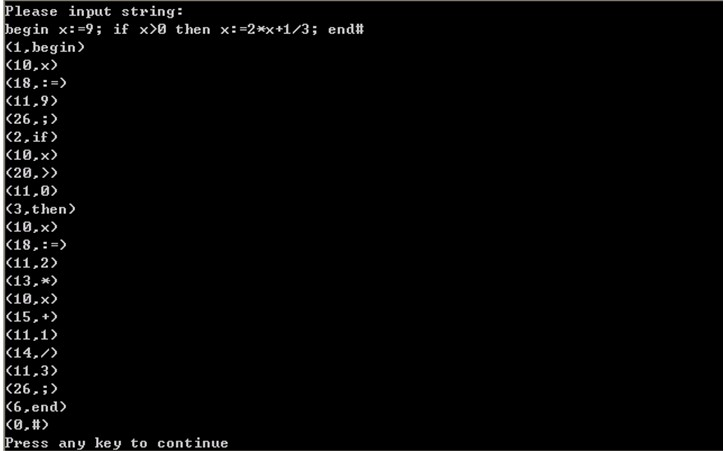一、 实验目的
编制一个词法分析程序
二、 实验内容和要求
- 输入:源程序字符串
- 输出:二元组(种别,单词本身)
- 待分析语言的词法规则
三、 实验方法、步骤及结果测试
- 1. 源程序名:压缩包文件(rar或zip)中源程序名 cifafenxi.c cifafenxi.exe
- 2. 原理分析及流程图

- 3. 主要程序段及其解释:
do
{
scanf("%s ",input);
i=0;
while(input[i] !='�')
{
//printf("char=%c ",input[i]);
if(input[i] == '+' || input[i] == '-' || input[i] == '*' || input[i] == '/' || input[i] == '=') //对字符串中的表达式做分词,并记录相应运算符
{
//printf(" hello ");
p=(NODE*)malloc(sizeof(NODE));
p->next=NULL;
p->string=(char*)malloc(sizeof(char)*2);
p->string[0]='�';
strncpy(p->string,&input[i],1);
p->next=yunsuanfu->next;
yunsuanfu->next=p;
// printf("yunsuanfu is %c ",input[i]);
}
else if(ispunct(input[i]) && input[i] != '~') //对字符串中出现界符的地方做分词,并记录相应界符
{
//ch=(char*)malloc(sizeof(NODE));
p=(NODE*)malloc(sizeof(NODE));
p->next=NULL;
p->string=(char*)malloc(sizeof(char)*2);
p->string[0]='�';
strncpy(p->string,&input[i],1);
p->next=jiefu->next;
jiefu->next=p;
}
i++;
}
ch=strtok(input,delim);
do
{
if(input[0] =='~')
break;
q=head;
p=(NODE*)malloc(sizeof(NODE));
p->next=NULL;
p->string=(char*)malloc(sizeof(input));
p->string[0]='�';
strcat(p->string,ch); //连接前后字符串,合成新的字符串
while(q->next !=NULL)
q=q->next;
p->next=q->next;
q->next=p;
}while(ch=strtok(NULL,delim));
}while(input[0] !='~');
if(strspn(p->string,biaowords)) //使用strspn()来对字符串中是否含有biaowords数组中的字符,若有则为标识符
{
q->string=p->string;
q->next=biaoshi->next;
biaoshi->next=q;
}

- 4. 运行结果及分析
一般必须配运行结果截图,结果是否符合预期及其分析。
(截图需根据实际,截取有代表性的测试例子)
四、 实验总结
这个实验一开始不是很能理解,感觉非常难,问了一些会的同学,参考了网上的一些资料,才逐步有了一些了解。这个实验需要为不同的关键词分配不同的种别码,再逐步输出,我的代码相比别人还很拙略,还要更加努力。